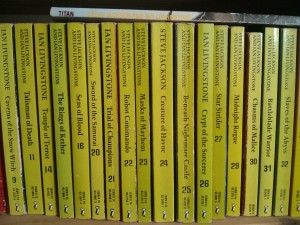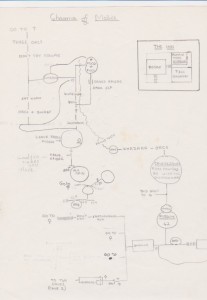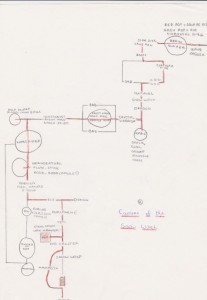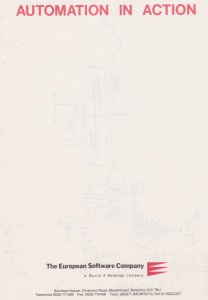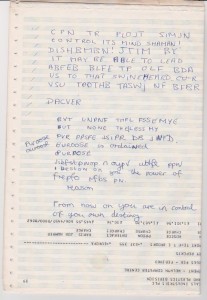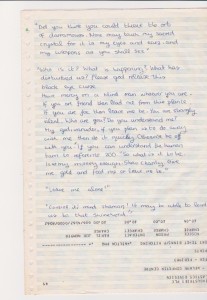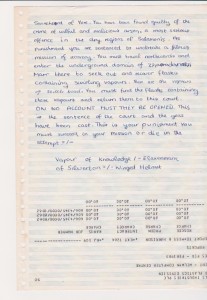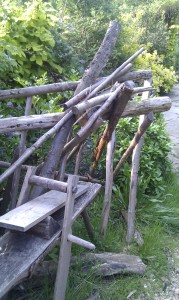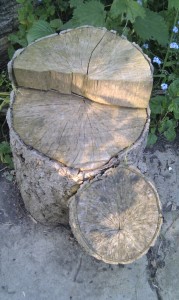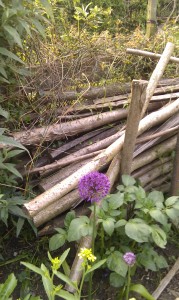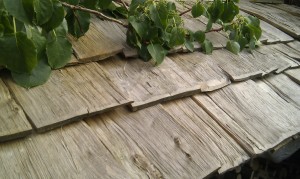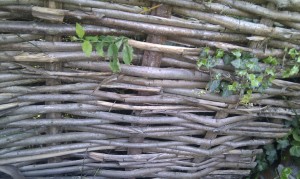Archive for the ‘spaces’ Category
mapping Fighting Fantasies
I found a folder down the back of a bookshelf. It was the shelf full of Fighting Fantasy books.
The first Fighting Fantasy book that Catherine & I bought was The Forest of Doom from the church jumble sale. I wonder if anyone raised an eyebrow at two little girls buying this?
I was thrilled by it. A book and a maze. A book that was a maze! So I bought more, one by one from the WHSmiths in Enfield shopping centre. I remember being appalled when Black Vein Prophecy cost £3.50. I thought they would always cost £1.95 or maybe £2.50 for a really hefty one. My first introduction to inflation.
The folder is full of maps. Maps of those book mazes.
Some are scrappy, works in progress, tools to help you along.
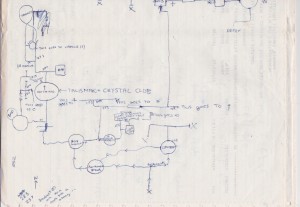
But some are too perfect and must have been redrawn once the book was completed. As a record, knowledge to be stored away.
There’s a stack on kids’ art paper but one map is drawn on the back of this.
And there’s a great deal of complex figuring out on the back of these green bar computer printouts.
This set is from “Imperial Chemical Industries” so must be stuff that Dad brought home. I remember narrower green bar printouts that Mum would bring home from the Broxbourne council IT department but there is none of that here.
The computer paper records the great frustration of my Fighting Fantasy stage. The Creature of Havoc.
I got stuck with The Creature, every option on every page seemed to lead to death. The map didn’t help. Decoding the encrypted bits in the text didn’t either. I went through the book page by page and found the end point that was about dying horribly. And then tried unsuccessfully to backtrack.
Today, with the internet, it took a few minutes to find out (as I had believed in 1988) the book was broken. But back then I just had to trust to the map.
an industry of hornbeam
I’m walking through our garden. There’s normal garden stuff: trees, shrubs, patio, table and chairs, a washing line. Not much lawn but that’s down to the chickens.
But all about there are also the signs that an (untidy?) craftsman works here.
A cleaving brake in the veg bed, a pole lathe that is fighting a losing battle with Boston Ivy, a shave horse sheltering under the jasmine, a persuader that has rolled under the rhubarb, chopping blocks next to the path, a saw horse that has perhaps seen better days.
All around there are remnants, waste, bits in need of a purpose: saw dust, wood shavings, cleaved sticks, trimmed ends, rejected twigs.
There are finished products too. Gate hurdles to protect the crops from pecking chickens and stampeding puppies. Woven hurdles screening compost and covering gaps in the fence. Beanpoles and pea sticks in the vegetable beds. Oak shingles on the wood shed and some spares in it. Firewood and kindling. Charcoal in bags in the shed.
It’s a strange sight in this urban garden although the neighbours are equally baffled by the chickens and even the normal horticultural stuff.
It stops people in their tracks when they stumble across Iain at work in the woods. We don’t think of woodlands as places of work, except maybe in the sense of industrial scale forestry in Canadian pine forests. Finding a lone guy with a pile of sticks and a billhook is a curiousity.
Our wood has ponds the agent claimed are ancient earthworks. Whatever the truth of that, it is unmistakable from the shape of the trees that sometime last century someone else worked these woods.
Woods were places of work and tools just as farms and cities are.
what Haringey thinks is my local area
One of the things that Haringey Council send us is the Haringey People “Local News” magazine for  Northumberland Park and White Hart Lane.
I largely disinterestedly flicked through the last one, none of the stories particularly catching my attention.
At the back was a nice little map of the area that shed light on my disinterest. This was clearly labelled “your local map” and helpfully explained “your local neighbourhood has been highlighted on the map of the borough”.
But IÂ don’t really go places in either of the two wards that Haringey has decided are my local area. My house is there (and my allotment!) but tube/rail stations, doctors, dentist, pubs, restaurants, shops, post office, parks, supermarkets and actual markets, vets, garden centres are all in other wards. Â Even my bus stop isn’t technically in *my* ward.
Partly this tells us that these wards are pretty deprived, even by Haringey’s standards. Not just financially but culturally. There’s not a lot of reasons for me to venture deeper into my own ward.
Another part of the problem is the print medium. Online they could have defined local in a circle around my location rather than relying on political boundaries. A circle would have been better but would still have a included a lot of space to the north that I’m not particularly interested in.
Local for me is stretched in a particular shape. That shape is formed by the gravitational pull of transport links into London (i.e to the south), the facilities available in the wealthier west of the borough but also by the cheap shops and restaurants further south.
I actually wanted to read the newsletters from all the six other local areas and not my own. Thanks to the internet I can but the glossy magazine is going to be rather a waste.
summer science
A good friend of mine is Young Scientist Centre Manager at the Royal Institution. The centre doesn’t open until September but in the meantime we were invited along to one of the Institution’s Family Fun Days.
We were treated to a lecture about the science of rock music, demonstrations of the world’s largest whoopie cushion, and received instructions on how to make two coat hangers sound like Big Ben (strangely the most impressive bit of the whole day).
On our friend’s recommendation we also went to the Royal Society for their Summer Science Exhibition.
This was a bigger, busier event with the emphasis more on cutting edge scientific research and less on hands-on stuff for kids. In retrospect I spent most time on the biology stands and now feel well educated about ladybirds and snails. Goo-making seemed to captivate the kids.
There seemed a curious bias amongst the medical stands which seemed strangely focused on female anatomy, including a stand with real human placenta in a bag, which provided the ick factor for the grown-ups.
We did a bad job of collecting all the freebies but we did come away with slinkys. So we were kept amused on the journey home.
I’d recommend both events to science fans (and to fans of grand buildings) but the RI event is particularly good if you’ve got kids.
crime documentary that avoids the usual moral panic
The Violent Highway is unusual for TV programmes about violent crime. Instead of an unquestioning “everything is getting worse” angle, the documentary instead looks at crime past and present, through the device of a single London street.
“the film recreates key incidents taken from 300 years of muggings, wife-beatings, pub brawls and serial killings. Historians, psychologists, residents of The Highway and former gang members discuss whether we are more or less violent than we used to be, and what this street can reveal about the violence in all of us.”
At one point the narrator starts the usual hackneyed point about how violent modern TV and video games are, but this only leads into Steven Pinker pointing out how we take pleasure in the violence in Greek and Shakespearean tragedy, and in murder mysteries too.
purple oyster card holder, plus map
The lovely Paula, as well as being a clever IA, is a talented crafter. She gave me this perfected pitched gift of one of her map-based Oyster card holders, in purple no less.
You can buy them from her Etsy shop.
slow down London
Later this month will be a London event I feel like I can get involved in (unlike the G20 protests…what was it they wanted again?)
Slow Down London is a ten day festival that sets out to encourage Londoners to improve their lives by slowing down to do things well.
Also coincidently discovered Academic Earth this week, kind of Ted talks but with guaranteed PhDs. In Paul Bloom’s lecture “The Good Life” he refers to two solutions to the hedonistic treadmill: keep doing different things or just get off the treadmill.
The Slow Down folks want to get off.
David Gauntlett’s inaugural lecture
I’m hugely looking forward to David Gauntlett’s inaugural lecture on 12th November.
“The particular significance of Tim Berners-Lee’s original vision is that it involved people making and sharing things – all users as contributors, not just readers. Thus began the shift from the ‘mass audience’ towards creative individuals and communities. David Gauntlett has had a long engagement with the Web, having produced the award-winning website Theory.org.uk for over a decade. Several years before the rise of ‘Web 2.0’, he was writing about the Web as a creative and collaborative playground of everyday culture, politics, and self-expression. He has continued to embed an interest in the Web with broader research about creativity and ways to engage people in social research and social issues.
Gauntlett considers these themes in the context of a broader growth in home-made culture, craft, recycling and remaking, which connects with environmental issues, transition towns and cities, and therefore – in one grand bound – the future of the planet. He will argue that this making-and-sharing culture may foster the ‘tools for thinking’ which will be required to solve social and environmental problems.”
The wine reception is all ‘sold out’ but that’s not the best bit, is it? Register for the free lecture here http://www.12november.org.uk/.
How Buildings Learn – TV series
Steward Brand has posted the six part BBC series of How Buildings Learn on Google Video.
(The BBC’s White City building features. Brand says of it that “basic daylight is an unattainable luxury”. It isn’t greatly beloved by staff but I’ve never had to work in it much. My current base, the Broadcast Centre, is a bit bland and boxy but mostly comfortable and functional. Television Centre and Bush House were both more inspirational buildings but quite flawed as places to work. The shape of TVC is distinctive but also enables you to literally go in circles when lost. )
i don’t want a slide at work
Work Happy Now blogged about the Google slide. Now call me grumpy but I don’t want a slide at work. It is just a bit too try hard, too “Look at us! Aren’t we crazy!”. It reminds me of guys with comedy ties.
I would like a giraffe in our atrium though.
